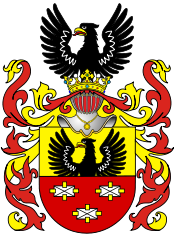
The Princely Houses of Poland
Encyclopedia
The Princely Houses of Poland differed from other princely houses
in Europe. Most importantly, Polish nobility (szlachta) could not be granted nobility titles by the Polish kings in the Polish-Lithuanian Commonwealth
. Therefore, the title of prince
either dated to the times before the Union of Lublin
, which created the Commonwealth in 1569, or was granted to some nobles (usually magnate
s) by foreign kings. Due to the longstanding history of common statehood
.
Prince
Prince is a general term for a ruler, monarch or member of a monarch's or former monarch's family, and is a hereditary title in the nobility of some European states. The feminine equivalent is a princess...
in Europe. Most importantly, Polish nobility (szlachta) could not be granted nobility titles by the Polish kings in the Polish-Lithuanian Commonwealth
Polish-Lithuanian Commonwealth
The Polish–Lithuanian Commonwealth was a dualistic state of Poland and Lithuania ruled by a common monarch. It was the largest and one of the most populous countries of 16th- and 17th‑century Europe with some and a multi-ethnic population of 11 million at its peak in the early 17th century...
. Therefore, the title of prince
Prince
Prince is a general term for a ruler, monarch or member of a monarch's or former monarch's family, and is a hereditary title in the nobility of some European states. The feminine equivalent is a princess...
either dated to the times before the Union of Lublin
Union of Lublin
The Union of Lublin replaced the personal union of the Kingdom of Poland and the Grand Duchy of Lithuania with a real union and an elective monarchy, since Sigismund II Augustus, the last of the Jagiellons, remained childless after three marriages. In addition, the autonomy of Royal Prussia was...
, which created the Commonwealth in 1569, or was granted to some nobles (usually magnate
Magnate
Magnate, from the Late Latin magnas, a great man, itself from Latin magnus 'great', designates a noble or other man in a high social position, by birth, wealth or other qualities...
s) by foreign kings. Due to the longstanding history of common statehood
Polish-Lithuanian Union
The term Polish–Lithuanian Union sometimes called as United Kingdom of Poland and Lithuania refers to a series of acts and alliances between the Kingdom of Poland and the Grand Duchy of Lithuania that lasted for prolonged periods of time and led to the creation of the Polish–Lithuanian...
.
| House | Arms Coat of arms A coat of arms is a unique heraldic design on a shield or escutcheon or on a surcoat or tabard used to cover and protect armour and to identify the wearer. Thus the term is often stated as "coat-armour", because it was anciently displayed on the front of a coat of cloth... |
|
|---|---|---|
 |
Czartoryski Czartoryski Czartoryski is the surname of a Polish-Ukrainian-Lithuanian magnate family also known as the Familia. They used the Czartoryski Coat of arms and were the leading noble family of the Polish-Lithuanian Commonwealth in the 18th century.-History:The Czartoryski is a family of a Grand Ducal... |
Pogon Litewska varied |
 |
Czetwertyński | Pogon Ruska |
 |
Drucki-Lubecki | Druck |
| Giedroyc | Hippocentaurus varied | |
| Jabłonowski | Prus III | |
 |
Lubomirski Lubomirski Lubomirski family is a Polish szlachta family. The family used the "Szreniawa without a cross" arms and their motto was: Nil conscire sibi .... |
Szreniawa bez Krzyza |
| Massalski | Massalski | |
| Ogiński | Brama | |
 |
Ossoliński Ossolinski Ossoliński is the surname of a Polish szlachta family. Because Polish adjectives have different forms for the genders, Ossolińska is the form for a female family member-History:... |
Topor |
 |
Poniatowski Poniatowski Poniatowski is an aristocratic family in Poland. Because Polish adjectives have different forms for the genders, Poniatowska is the same name for a female family member.-History:... |
Ciolek |
| Poniński | Lodzia | |
| Puzyna Puzyna Puzyna is a Rurikid princely house, now already for several centuries living in Poland. Originally they were from Belarus and region of Smolensk.Their most prominent members lived in early 20th century.* material: Russian wikipedia... |
Puzyna od. Brama. | |
| Radziwiłł | Traby od. Radziwiłł | |
 |
Sanguszko Sanguszko Sanguszko is a Polish-Lithuanian noble family of the Ruthenian Sanguszko is a Polish-Lithuanian noble family of the Ruthenian Sanguszko is a Polish-Lithuanian noble family of the Ruthenian (now Ukrainian stock from the Gediminid dynasty. Like other princely houses of Polish-Lithuanian... |
Pogon Litweska |
 |
Sapieha Sapieha The Sapieha is a Polish-Lithuanian princely family descending from the medieval boyars of Smolensk. The family acquired great influence in the sixteenth century.-History:... |
Lis |
 |
Sułkowski | Sulima |
 |
Woroniecki | Korybut |
 |
Zajączek | Swinka |
| House | Arms Coat of arms A coat of arms is a unique heraldic design on a shield or escutcheon or on a surcoat or tabard used to cover and protect armour and to identify the wearer. Thus the term is often stated as "coat-armour", because it was anciently displayed on the front of a coat of cloth... |
|
|---|---|---|
 |
Borowski | Gozdawa |
| Glinski | Hlinski | |
| Kurczewicz | Kurcz | |
 |
Łukomski | Roch III/Pierzchała od. Łukomski. |
| Mirski | Białyna | |
| Podhorski | Podhorski | |
 |
Polubinski | Jastrzębiec od. Polubinski |
 |
Radolin | Leszczyc |
 |
Pogon Ruska | |
 |
Swirski | Lis |
See also
- List of szlachta
- List of Polish coats of arms
- List of Polish rulers
- Offices in Polish-Lithuanian Commonwealth

